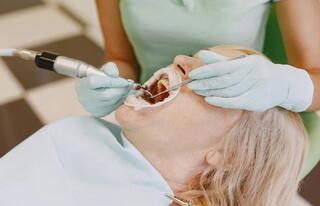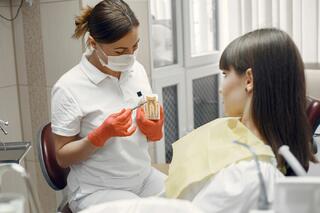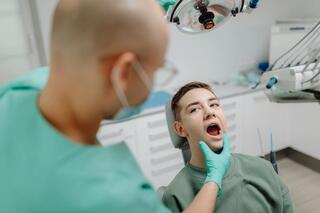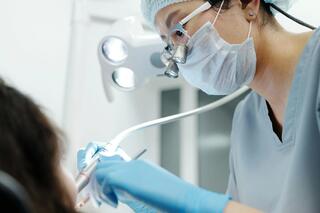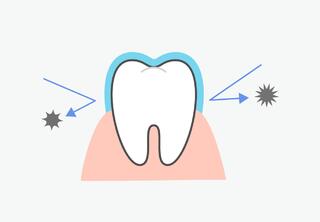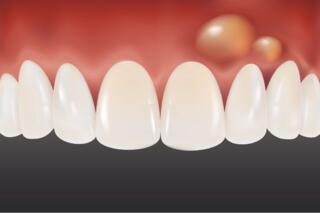What is Ultrasonic Dental Cleaning?
Ultrasonic dental cleaning is an excellent method of professional oral hygiene. Ultrasound effectively removes various deposits, both above and below the gums. It equally removes soft plaque and hard tartar.
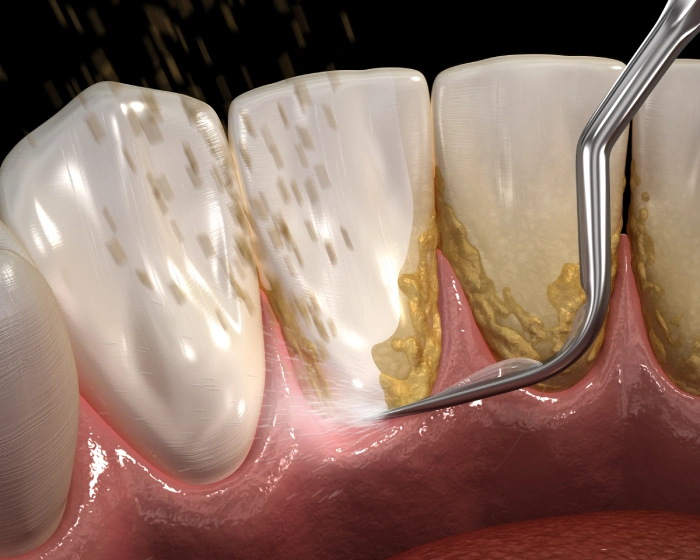
Differences between Periodontitis and Periodontosis
| Question | Answer |
|---|---|
| How long does the procedure take? | A standard dental cleaning takes about 1 hour. More complex cases may require up to 2 hours. |
| How often should ultrasonic cleaning be done? | It is recommended to undergo cleaning every six months. With good daily hygiene and no bad habits, it can be done once a year. Smokers and those who enjoy strong tea or coffee, as well as individuals with irregular bites or braces, are advised to clean every 3 months. |
| Is the procedure painful? | The procedure is not painful, only a slight vibration is felt. |
| Can children undergo ultrasonic cleaning? | Ultrasonic cleaning is not recommended for teenagers until their bite has fully developed. It can start two years after all permanent teeth have emerged. Gentler methods are chosen for children. |
| Does it contribute to teeth whitening? | Crowns become lighter by removing colored plaque and tartar. However, the color of the enamel does not change significantly. |
| Are all deposits removed at once? | Usually, all deposits are removed at once. But patients with severe periodontitis may require multiple visits. |
| Will the gums bleed after the procedure? | If the gums are healthy, there is no bleeding. However, patients with thin, inflamed gums may experience minor bleeding. |
| Does everyone need professional oral hygiene? | Yes, professional oral hygiene is necessary for everyone. Even with perfect hygiene, hard-to-reach plaque accumulates, which over time becomes tartar and cannot be removed with conventional means. |
How Does Ultrasonic Dental Cleaning Work?
Ultrasonic dental cleaning uses a device that consists of:
- Adapters for supplying water or antiseptic.
- Various tips, each with a specific purpose. The dentist uses several tips of different shapes and sizes.
- A scaler that generates ultrasonic waves with adjustable power from 16 to 45 kHz. Lower frequencies are suitable for sensitive areas, higher for removing hard plaque.
Cleaning is achieved through:
- Vibrations of the tips, with which the dentist moves over the teeth. Ultrasonic waves break down plaque and tartar, while water or antiseptic cools and cleans the surface.
- Cavitation, where ultrasonic waves in water create microbubbles that burst and help dislodge deposits.
Indications and Contraindications
Ultrasonic dental cleaning is recommended for:
- Treating gum diseases;
- Improving tooth color, as deposits affect the color of the enamel;
- Caring for braces, prostheses, implants;
- Preparing for implantation or orthopedic treatment;
- Removing plaque and tartar on and under the gums.
The procedure is not recommended for individuals with:
- Respiratory diseases;
- Hepatitis, tuberculosis, HIV;
- Pacemakers;
- Epilepsy;
- Severe cardiovascular problems;
- Viral infections;
- Mental disorders.
How Ultrasonic Dental Cleaning is Performed
-
Consultation.
Duration: 10 minutes. The dentist examines the oral cavity, assesses the condition of the teeth and gums. He listens to the patient's complaints and chooses the appropriate treatment method. -
Anesthesia.
Duration: Up to 15 minutes. It is necessary for patients with thin enamel, deep subgingival deposits, inflamed gums, or hypersensitivity. Surface anesthesia is applied using a spray or a solution for rubbing onto the gums. -
The actual cleaning.
Duration: 30 minutes. The doctor thoroughly cleans each tooth, its neck, and root. -
Polishing.
Duration: Up to 20 minutes. After removing large deposits, small particles remain on the teeth. They make the enamel rough, facilitating the adherence of pigments and plaque. To maintain the effect of the procedure, the dentist polishes the teeth using special brushes, interdental strips, and abrasive pastes or the Air Flow device. -
Application of strengthening agents to the teeth.
Duration: is about 10–15 minutes. After removing the deposits, the enamel better absorbs minerals. A remineralizing varnish or a solution with fluoride and calcium is applied. This also reduces tooth sensitivity. The cost of this treatment is not included in the ultrasonic cleaning price and is charged separately.
If you have only a light coating and healthy gums, the procedure can be performed by a dental hygienist. However, if tartar under the gums, gingivitis, or periodontitis has accumulated, a consultation with a periodontist is advised. This specialist will thoroughly clean the gum pockets and prescribe anti-inflammatory and antibacterial treatment.
Advantages and Disadvantages of the Procedure
Advantages of Ultrasonic Cleaning:
- Gum massage.
- Antibacterial effect due to cavitation.
- The procedure is painless.
- The result lasts at least six months with proper hygiene.
- Removes all types of dental plaque: bacterial film, pigmented plaque, tartar.
- Whitens enamel by 1–2 shades.
- Options for wave power and various tips for different dental areas.
- Safety of the procedure.
- Prevents cavities, gingivitis, periodontitis, and other dental diseases.
- Thorough cleaning of all areas, including interdental and cervical regions, as well as periodontal pockets.
Disadvantages:
- Not recommended for people with multiple fillings and prosthetics.
- Possible discomfort for patients with hypersensitivity and damaged gums.
- Possible enamel damage when using low-quality equipment with elliptical tips.
- Increased sensitivity in the neck area of the teeth, lasting a few days. Can be prevented with fluoridating and remineralizing agents.
Yes, I use a state-of-the-art device that operates with straight movements of the tools and does not damage the enamel. I do not treat teeth with fillings, crowns, veneers, or implants with ultrasound. For these cases, I use alternative equipment.
Ultrasonic Tooth Cleaning or Air Flow?
Air Flow is an effective professional dental hygiene method. It can be used either alone or in combination with ultrasonic cleaning for polishing crowns in the final stage.
The Air Flow technique is similar to sandblasting. A mixture of compressed air, water, and fine sodium bicarbonate is directed under pressure onto the enamel. The particles effectively remove plaque, while the water-air mixture washes away the remnants.
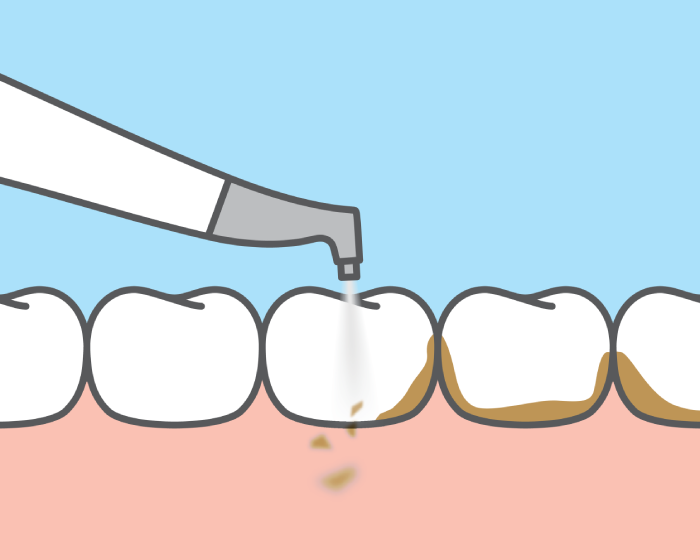
Air Flow is a safe and gentle method. It does not harm teeth, implants, or restorations made of composite and ceramic. However, it only removes superficial deposits.
Air Flow is suitable if you have:
- Small dental stones;
- Light plaque;
- Periodontal pockets up to 5 mm;
- High sensitivity or low pain threshold;
- Multiple fillings, crowns, implants;
- Inflamed, thin, or bleeding gums.
Only the doctor decides which type of cleaning is suitable for a particular patient: ultrasonic or Air Flow. Make an appointment with a dentist at a clinic near you.
Determining the Type of Dental Cleaning
Only a doctor can determine which type of cleaning is suitable for a patient: ultrasonic or Air Flow. Make an appointment with a dentist at your nearest clinic.
What to Avoid After Ultrasonic Dental Cleaning
To maintain the results of ultrasonic cleaning longer, it's important to take meticulous care of oral hygiene. Electric toothbrushes and irrigators are recommended.
Avoid the following:
- Avoid consuming staining drinks and foods for the first 48 hours. Follow a "white diet". Avoid coffee, tea, red wine, colored soft drinks, beetroot, tomatoes, carrots, blueberries, and blackberries.
- Do not smoke for 1–3 days. If it's difficult, try not to smoke for at least a few hours.
- For 3 days, avoid cold, hot, acidic, spicy, and hard food. These can cause pain due to the sensitivity of the teeth after cleaning.
- Do not use an old toothbrush. Replace it with a new one with soft or medium bristles.
- Do not use herbal infusions for rinsing the mouth, as they can stain the enamel. For treating inflammation and gum bleeding, alcohol-free pharmaceutical antiseptics are more suitable.
Frequently Asked Questions
How long does the procedure take?
On average, the procedure lasts about 1 hour.
Is ultrasonic dental cleaning painful?
Most patients only feel a vibration during the oscillation of the ultrasonic tip. Minor pain sensations may occur in people with inflamed gums, deep periodontal pockets, thin enamel, and sensitive tooth necks. For such patients, we use topical anesthesia.
How often should ultrasonic cleaning be done?
It is recommended every 6 months, but can vary depending on individual needs.
Does ultrasonic cleaning whiten teeth?
It removes pigmented plaque, making teeth visually brighter, but does not change the color of the enamel.
Can gums bleed after the procedure?
Minor bleeding is possible in patients with inflamed gums, but usually, it is not a problem.
Does ultrasonic cleaning help prevent gum disease?
Yes, it helps remove bacterial plaque, which can cause gum diseases.
Is ultrasonic cleaning safe for pregnant women?
It is not advisable. Oral hygiene should ideally be done during pregnancy planning. However, if there is significant plaque accumulation, tartar, or gum inflammation during pregnancy, the procedure is necessary. Pregnant women are better off using Air Flow instead of ultrasound.
Does a scaler replace professional dental cleaning?
Cleaning with a scaler is one of the methods of professional hygiene in dentistry. It is used in the first stage of removing dental deposits. Polishing is performed in the final stage.
When can you eat after the procedure?
After 3 hours. Choose soft, non-sticky foods without dyes. Meals should be slightly warm.
Can it be done when wearing braces?
People with braces need professional cleaning. Food particles and plaque accumulate extensively between the power arches, ligatures, brackets, and teeth. They cannot be removed with an irrigator, interdental brush, floss, or toothbrush. Ultrasonic should be used only for the gum area, while crowns should be cleaned with Air Flow. The same applies to patients with prostheses or implants.
